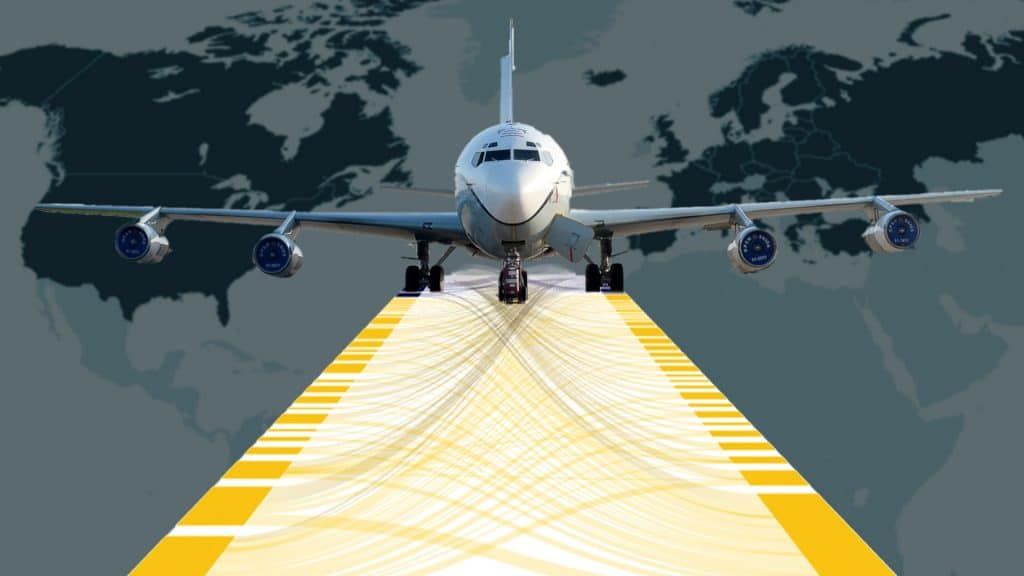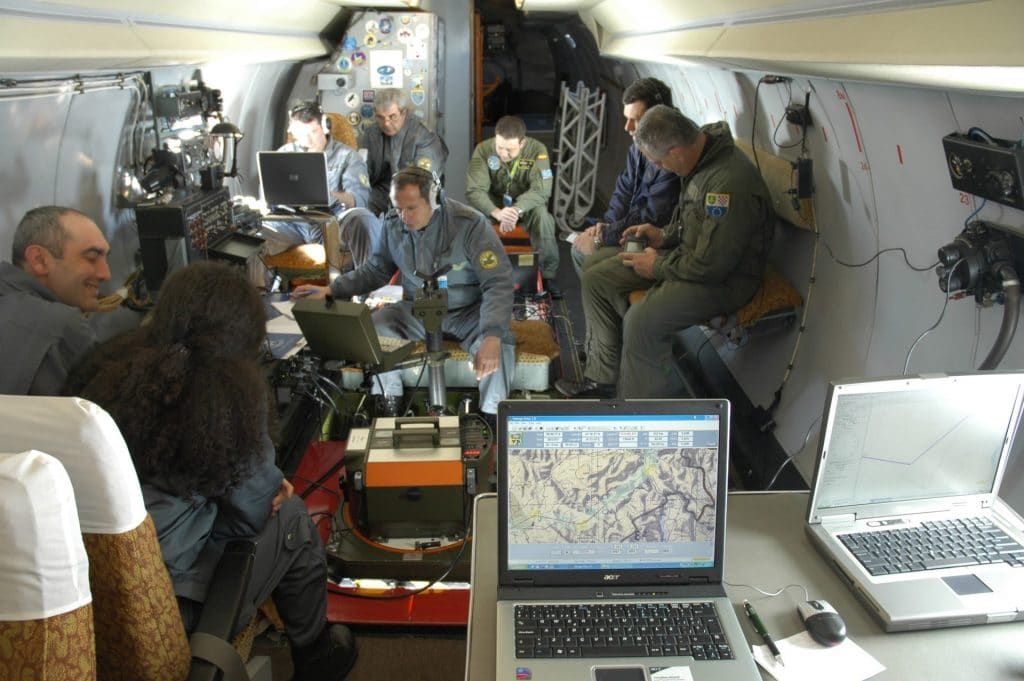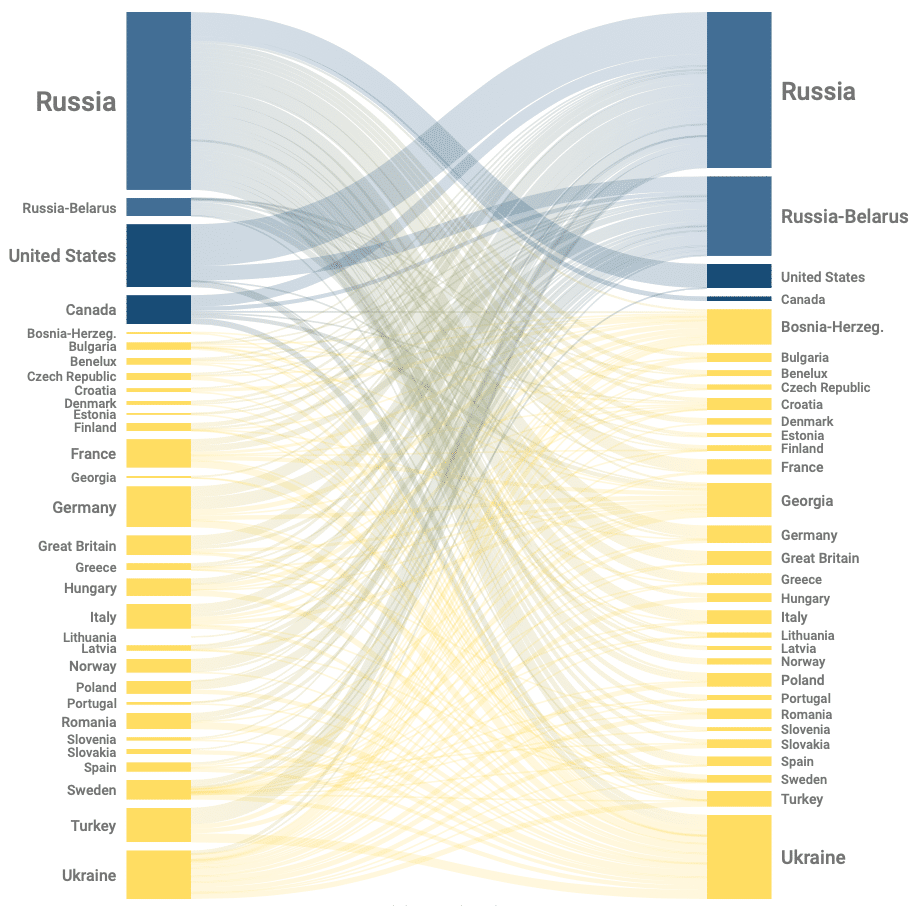What the United States loses by quitting the Open Skies treaty, in one chart
By Thomas Gaulkin | April 13, 2020
 Illustration by Thomas Gaulkin
Illustration by Thomas Gaulkin
Reports emerged this week that the White House may be moving “soon” on withdrawing from the Open Skies treaty, a nearly two-decade-old agreement that allows 34 countries to fly and share reconnaissance missions over each other to promote military cooperation and transparency.
Last month, defense secretary Mark Esper said he was freezing a long-overdue replacement of the aging OC-135B aircraft used for flights under the treaty. “Until we make a final decision on the path forward, I am not prepared to recapitalize aircraft,” Esper told the Senate Armed Services Committee. Although more than 1,500 observation flights have been flown since the treaty took effect in 2002, vocal Republican opponents like Sens. Tom Cotton, Richard Burr, and Ted Cruz claim its benefit is “marginal” because US satellites make aerial imagery unnecessary, and the United States gives up more to its adversaries under the treaty than it gains. Their criticism extends from complaints about the costs of the OC-135B upgrade to protests over Russian compliance with the treaty—specifically, restrictions on missions flown over Kaliningrad and along Russia’s border with Abkhazia and South Ossetia. Cotton and Cruz introduced a resolution calling for withdrawal in October.
Meanwhile, foreign policy veterans from multiple administrations have called on the White House to reconsider. This week, Democratic leaders from the House and Senate committees on armed services and foreign relations said that the action would be “not only shortsighted, but also unconscionable,” and urged the Trump administration “to reverse course on this reckless policy decision rather than ramming it through while our country and the entire world grapples with an unprecedented crisis.” Proponents note that the images gathered during flights are important to US allies in Europe who have limited access to satellite surveillance and that the treaty allows the United States to receive imagery even from flights it does not conduct itself. On Russian compliance, they argue that any issues can best be addressed via the treaty itself, not by abandoning it—an argument that failed to halt the Trump administration’s withdrawal from the INF treaty last year.
Originally proposed in 1955 by President Dwight D. Eisenhower as a means of reducing Cold War tensions and assisting arms control inspections, the Open Skies treaty found its footing only as the Soviet Union was falling apart, when (quoting the treaty’s preamble) events in Europe “transformed the security situation from Vancouver to Vladivostok.” The idea was to encourage that new spirit of cooperation by placing representatives of potential adversaries on the same airplanes, jointly collecting intelligence that all treaty signatories have access to.

“What is important is that these people, the military officers, they sit together in one plane, together with their counterparts, all the time,” Alexander Graef, a researcher in the arms control and emerging technologies project at the Institute for Peace Research and Security Policy in Hamburg, told the Bulletin. “They engage with them on a daily basis, and you cannot replicate that with satellites. So that is something, a human factor, that’s in the treaty.”
While information about the joint flights under the treaty is not classified, researchers and journalists have generally had to glean details from a mix of sources. One frequently cited source is the US State Department itself, which previously maintained a comprehensive list of flights on its website. But that information has not appeared since Trump took office.
So earlier this month, Graef and his colleague (and Bulletin Rieser award winner) Moritz Kütt decided to publish figures based on exhaustive flight data they received from a NATO source on all Open Skies missions from 2002 through 2019. They set up a website, OpenSkies.flights, that quantifies the overall flight records and features an interactive graphic to help visualize the extent to which states have continuously cooperated on overflights since the treaty took effect—and, they hope, undermine arguments for US withdrawal.

The United States receives (as shown on the right side of the diagram) far fewer flights over its territory than it flies over others’ (as shown on the left side). Graef and Kütt calculate that approximately 94 percent of reconnaissance flights under the Open Skies treaty were flown over European states, including Russia.
Moreover, the visualization makes plain that there are really two main blocs gathering observations of each other under the treaty: European states and Russia (including Belarus, which is grouped with Russia under the terms of the treaty). “Thus, even if the United States left the treaty, Europe could still derive benefits from overflying Russia-Belarus,” Graef and Kütt wrote. “In turn, although Russia-Belarus would lose the ability to fly over the United States, it would retain the right to conduct overflights over European states and Canada, which together currently account for more than 87 percent of its active flights.”
“One of the things we show is that the Americans fly way more often over Russia than the Russians fly over them,” Kütt said. And because any imagery can be shared among all states, the United States doesn’t even need to actively participate in missions over European states to receive copies of the intelligence that Russia obtains.
“[The United States] benefits the most by having the capability of flying over Russia, not flying over Europe, and in return not receiving as many flights,” Kütt said.
At a 2017 congressional hearing on Russia’s violations of the INF treaty, Jon Wolfsthal, former National Security Council Senior Director for Arms control and Non-proliferation (and Bulletin Science and Security Board member), described Open Skies as part and parcel of the broader international security regime. “We have to view all of these treaties as a network,” he said. “They are designed to create stability and predictability in the European theater.”
But even as the treaty was coming into force, there was skepticism about its longevity in a global security environment that was changing quickly after 9/11. In an article for the January/February 2002 issue of the Bulletin, political scientist James Marquardt wrote, “Now, nearly 50 years after it was first proposed, Open Skies seems antiquated. In a sense, it is a fair-weather friend, the product of a favorable international climate—just as its past failures were the result of mutual distrust and suspicion.”
This year, anticipating the possibility of a withdrawal from the treaty, legislators included a clause in the 2020 National Defense Authorization Act that requires both the secretaries of state and defense to notify Congress four months before any formal notice of intent to withdraw. The earliest the administration can provide the other members of the treaty notice would then be close to September. The decision would not take effect for another six months after that. All 34 states would first meet to consider the consequences for the treaty—which, Graef says, could even include wholesale abandonment.
When White House officials floated the idea of withdrawing from the treaty last fall, Vladimir Ermakov, the head of the Russian foreign ministry’s arms control and non-proliferation department said the government was already prepared to respond. “You’ll find out,” he said. But Russian officials also backed the treaty and voiced greater caution. Deputy Foreign Minister Sergey Ryabkov said, “We cannot simply mirror [the US response].”
In a Twitter exchange with Graef last week, however, Russia’s permanent representative to international organizations in Vienna, Mikhail Ulyanov, suggested US withdrawal might make Russia reconsider its commitment to the treaty since the United States could unfairly benefit from it even after it withdraws.
I am not sure that without US the Treaty will constitute interests for us. Russia would be discriminated against. NATO member states would definitely share data about Russia with US which would be free of our overflights.
— Mikhail Ulyanov (@Amb_Ulyanov) April 1, 2020
Whether or not that concern would be sufficient for Russia to give up on the treaty, and even if the United States doesn’t move forward with withdrawal this fall, there may already be an impact on the treaty’s implementation, since states meet every year to agree on the exact distribution of missions that will be flown. Graef noted that the Open Skies treaty review conference, held once every five years, coincides with the annual flight quota negotiations this year in October. “There could be a true culmination of events,” Graef said.
The practical consequences for US withdrawal from the treaty are less dire in the short term. Kütt said that one certain effect would be an to end shared flights on US aircraft. According to the data they received, Graef and Kütt said the US carried out 112 Open Skies flights on the OC-135B planes between 2002 and 2019, about half of which were shared observation missions with European states or with Canada. But several European countries have aircraft that are fitted for flights under the treaty and leased for overflights by other states, and Germany recently acquired an Airbus A319 plane specially modified for observation flights. “European countries should be able to cover for lost aircraft capacity,” Kütt said.
The longer-term consequences, though, could be more serious. In addition to losing an important mechanism for building trust between increasingly antagonistic states, some experts speculate that those opposed to the existing arms control regime will use withdrawal from the Open Skies treaty to justify calls for an exit from New START—on the grounds that New START verification will be hindered without the intelligence gathered via Open Skies.
So you will likely hear the talking point that, once we pull out of OST, we lose ability to monitor NST. So we should pull out of that, too. Talking point is not true, NST does not need OST data, but I've already heard critics try this line of reasoning.
— ChartAI (@Mr_Winner___) April 7, 2020
At a December 2015 Congressional hearing on Russia’s INF violations, Oklahoma representative (now NASA administrator) Jim Bridenstine tried to pin down then under secretary of state for arms control Rose Gottemoeller on the threat posed by Russian overflights and continued US support for the treaty. Gottemoeller’s understated parry: “It is important again to bear in mind the importance that our allies and partners place upon this treaty, and to make a good calculation of what particular risks predictability and openness have for our national security. We judge that this treaty does not pose such risks to our national security.”
As Graef and Kütt demonstrate, the United States has never taken full advantage of its potential flights. The treaty allows up to 42 US observation flights over other countries each year—it has always flown fewer than half of them. But, remarkably, in the months since withdrawal became more probable, the US has actually scheduled more flights under the treaty than ever before. The Covid-19 pandemic has forced a temporary halt to Open Skies mission, but Vayl Oxford, director of the Defense Threat Reduction Agency, told the House Armed Services Committee in February that the strategic value of every mission had been increased, and that if all 21 proposed missions this year are flown, “It’d be the busiest Open Skies season ever.”
Together, we make the world safer.
The Bulletin elevates expert voices above the noise. But as an independent nonprofit organization, our operations depend on the support of readers like you. Help us continue to deliver quality journalism that holds leaders accountable. Your support of our work at any level is important. In return, we promise our coverage will be understandable, influential, vigilant, solution-oriented, and fair-minded. Together we can make a difference.
Keywords: Donald Trump, Europe, Open skies treaty, Russia, United States, arms control, data analysis, international cooperation
Topics: Nuclear Risk














